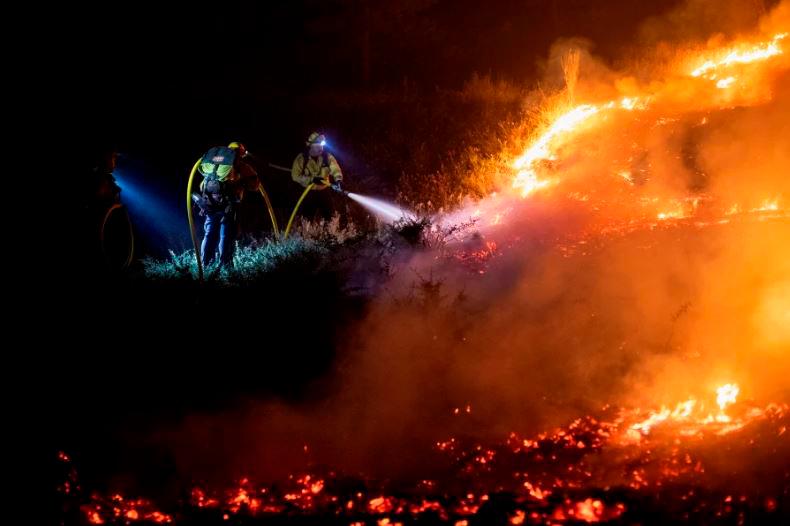LOS ANGELES: Cooler weather on Thursday aided firefighters battling out-of-control blazes around Los Angeles, but officials warned the fast-moving fires were unpredictable and could suddenly explode.
Around 173 square miles (450 square kilometers) have been torched in the three fires, which have destroyed dozens of homes and forced hundreds of families to flee.
One woman whose home was leveled by the fast-moving Line Fire northeast of the city said she and her children had only minutes to evacuate.
“It happened really fast,“ Brooke Palenchar told broadcaster KTLA.
“We weren’t able to grab much before we left... I have about three Tupperwares left of our lives.”
Footage from the home showed only a brick chimney standing among twisted metal and charred debris.
Investigators believe the fire, which has consumed 37,000 acres (15,000 hectares) in a week, was started deliberately.
Justin Wayne Halstenberg, 34, from Norco has been arrested on suspicion of arson. Reports Thursday said detectives believe he may be a serial arsonist.
Thousands of firefighters from across the region are tackling the vast fire, working long, intense days.
“Our shifts are 24 hours, but due to the crew rotation, we end up working about 28-hour shifts,“ Captain Kyle Arledge of Ventura County Fire said.
- Pyrocumulous clouds -
To the west, the Bridge Fire in the Angeles National Forest -- the largest active blaze in California -- has now swelled to over 51,000 acres, destroying at least 33 homes.
Pictures from the town of Wrightwood show charred vehicles and the wreckage of buildings wreathed in smoke.
Three people -- including an off-duty sheriff's deputy -- who had been trapped by the fire in a remote area near Mt. Baldy were brought to safety on Wednesday.
Firefighters said the blaze remained entirely uncontained, and warned that it could suddenly explode because of the abundance of dry vegetation.
This could mean “the potential for large energy release that could create plume-driven fire behavior and column collapses, which may send spot fires out ahead of the fire's direction,“ said an update from Cal Fire, the statewide fire agency.
Plume-driven fires happen when a blaze begins to generate its own localized weather, forming what is called a pyrocumulous cloud.
Smoke from the fire stops the hot air from rising and forces it back down, creating gusts that can fan the flames, similar to the downdraft of a thunderstorm.
“Those winds can essentially go in any direction which makes it extremely dangerous in terms of fire growth at the surface,“ National Weather Service meteorologist Bryan Lewis told the San Gabriel Valley Tribune.
- 'Herculean effort' -
Southeast of Los Angeles, the Airport Fire was still growing, but cooler temperatures were making the battle easier.
The blaze erupted on Monday and began racing up canyons and hillsides.
Photographs and video from the Lake Elsinore area show houses and vehicles have been devastated.
Orange County Fire Authority Captain Steve Concialdi said a cooldown after days of stifling heat has brought much-needed relief, with the return of a morning blanket of cool and moist air from the sea.
“This marine layer and cooler temperatures along with the higher relative humidity are helping firefighters grow our containment... and extinguish hot spots,“ he said.
California Governor Gavin Newsom, who has declared a state of emergency in response to the fires, visited the command post at the Line Fire on Wednesday.
“California is deploying every available resource to combat these devastating fires, and we’ll continue to work in lockstep with federal and local partners in this Herculean effort,“ he said.
Wildfires are a natural part of the wilderness cycle and are not unusual in California and other parts of the US West at this time of year.
But scientists say human-caused climate change is altering weather patterns and making natural cycles less predictable.
Two wet winters that sparked rapid growth of vegetation, coupled with two mild fire seasons have left large swathes of southern California primed to burn.









